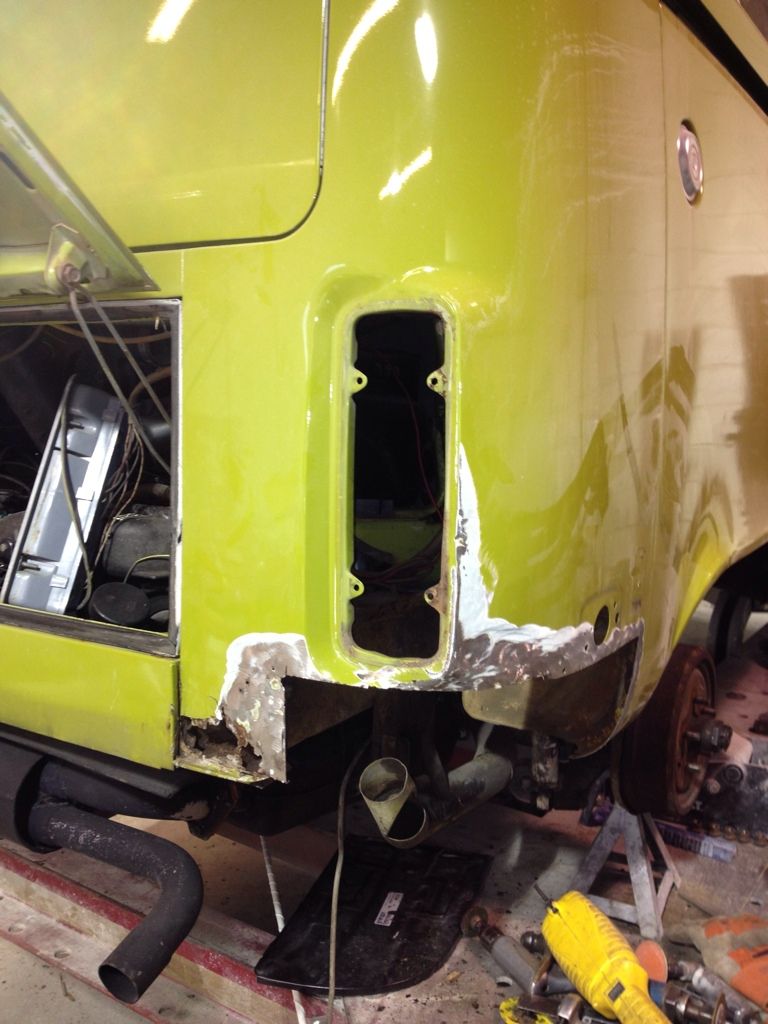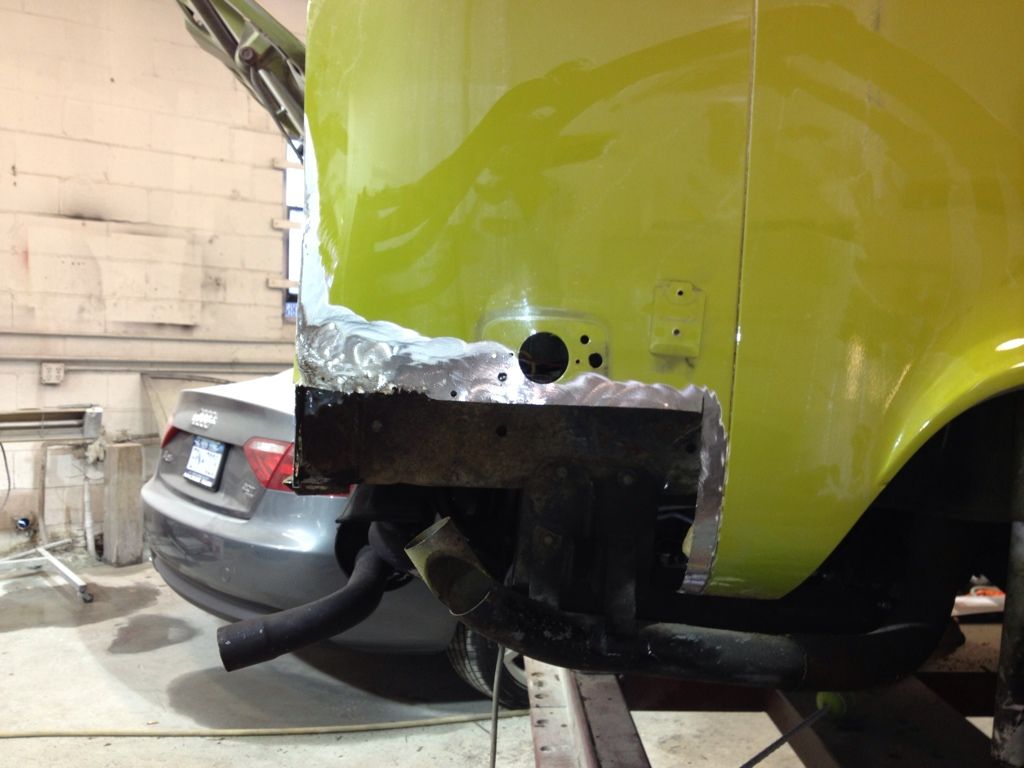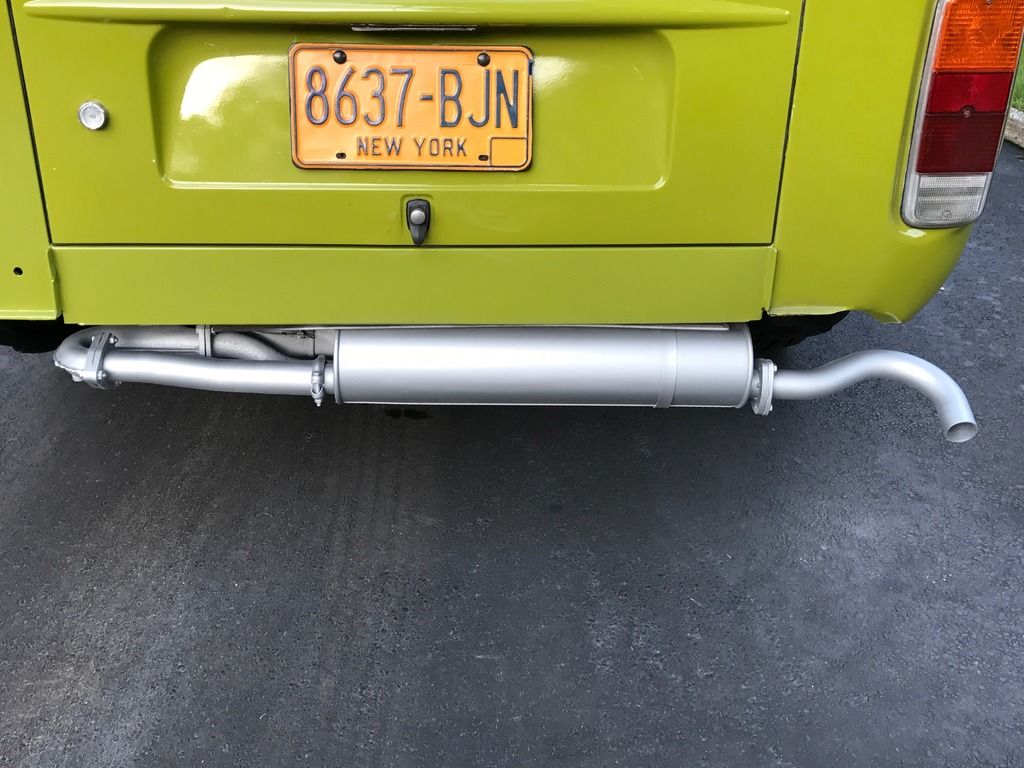#2 compression = 60
Re: #2 compression = 60
I would look at the heater boxes, maybe a hole you can't see which you need to know anyway before you get carbon monoxide poisoning . 
I'm not an air cooled snob , I like them all !
Brown wrote:Tom is right!
- ObnoxiousBlue
- Site Admin
- Posts: 1422
- Joined: Tue Sep 09, 2008 5:23 pm
- First Name: Mike
- Vehicle Year: 1964
- Model: Beetle
- Location: Above ground...
- Contact:
Re: #2 compression = 60
When you say loud like a Harley, you mean the exhaust was loud? Or was it a tapping - hydro lifters?
When you talk about your exhaust - how many pieces are there? An eliminator exhaust is common now, especially on late bays as there are very few exhaust suppliers out there for the 2.0's.
The eliminator has two flanges - one off each head - that each merge into a single muffler. The stock exhaust had a cross over pipe with a flange at both head, then it had a collector, a U bend, followed by an extension or a CAT if so equipped, a second extension to mate with the muffler, then a tail pipe. Each of these had connections in between. You can see why the stock set up fell out of favor over the much simpler to install eliminator (or extractor) muffler.
In my experience, the new eliminator sets are very flimsy, not only are the flanges never level, but the materials are thin, and they are prone to breaking at the seams, rusting, and causing a loud "hiccup" type exhaust note.
I scrapped mine altogether and went back to stock. It made the bus sound 1000% better - that was before my engine rebuild ::cough cough::
Here you can see an extractor muffler - notice it mounts right to the heads.
It is the flat-black unit on the edge of the photo. The silver exhaust-pipe-looking pipe is the dump tube found on stock 77-78 2.0's.


This is the stock set up.
Depending on the ports you have you might be even BETTER off using stock.
The 77 ran tri flanges. Earlier, and yet again later buses used trapezoidal flanges. While the flange isn't the issue, the systems are best identified by the flange. The systems are not interchangeable without changing the heads. I opted to stay stock and thus my 77 got the FAR more complicated stock system. The trap flange systems were a bit more simplified and even more readily available.

When you talk about your exhaust - how many pieces are there? An eliminator exhaust is common now, especially on late bays as there are very few exhaust suppliers out there for the 2.0's.
The eliminator has two flanges - one off each head - that each merge into a single muffler. The stock exhaust had a cross over pipe with a flange at both head, then it had a collector, a U bend, followed by an extension or a CAT if so equipped, a second extension to mate with the muffler, then a tail pipe. Each of these had connections in between. You can see why the stock set up fell out of favor over the much simpler to install eliminator (or extractor) muffler.
In my experience, the new eliminator sets are very flimsy, not only are the flanges never level, but the materials are thin, and they are prone to breaking at the seams, rusting, and causing a loud "hiccup" type exhaust note.
I scrapped mine altogether and went back to stock. It made the bus sound 1000% better - that was before my engine rebuild ::cough cough::
Here you can see an extractor muffler - notice it mounts right to the heads.
It is the flat-black unit on the edge of the photo. The silver exhaust-pipe-looking pipe is the dump tube found on stock 77-78 2.0's.


This is the stock set up.
Depending on the ports you have you might be even BETTER off using stock.
The 77 ran tri flanges. Earlier, and yet again later buses used trapezoidal flanges. While the flange isn't the issue, the systems are best identified by the flange. The systems are not interchangeable without changing the heads. I opted to stay stock and thus my 77 got the FAR more complicated stock system. The trap flange systems were a bit more simplified and even more readily available.

Re: #2 compression = 60
He has a 79 and I am assuming square port heads, I am using the square port heads on my engine and there is no crossover pipe. The exhaust from the manifold goes directly to the heater boxes.
I'm not an air cooled snob , I like them all !
Brown wrote:Tom is right!
- ObnoxiousBlue
- Site Admin
- Posts: 1422
- Joined: Tue Sep 09, 2008 5:23 pm
- First Name: Mike
- Vehicle Year: 1964
- Model: Beetle
- Location: Above ground...
- Contact:
Re: #2 compression = 60
That would be correct for a 79. Sorry, I didn't notice his signature.
The 79 had the muffler connect directly to the heads - no leader pipes like on the extractor or cross over like on the earlier-late bays.
Good news then is that there are some real good exhaust options out there for your bus, up to and including stainless...
NOICE.
The 79 had the muffler connect directly to the heads - no leader pipes like on the extractor or cross over like on the earlier-late bays.
Good news then is that there are some real good exhaust options out there for your bus, up to and including stainless...
NOICE.
-
Markus
- Posts: 140
- Joined: Thu Jan 30, 2014 8:51 am
- First Name: MarkusK
- Vehicle Year: 1979
- Model: Bus
Re: #2 compression = 60
Thanks for the responses guys. So the Bus is a 79 with a 78 engine. 2.0, oval port heads and confirmed solid lifters. The head pipes go to a U bend to each side heater box. Then the heater boxes straight to the round muffler like the black one mike posted in the first picture.. all triangle flanges.
and yes mike, I mean the exhaust is loud. Even at idle.
I was away for a week. i'll get back under it this weekend.
and yes mike, I mean the exhaust is loud. Even at idle.
I was away for a week. i'll get back under it this weekend.
1979 Deluxe Westfalia FI 2.0
-
Markus
- Posts: 140
- Joined: Thu Jan 30, 2014 8:51 am
- First Name: MarkusK
- Vehicle Year: 1979
- Model: Bus
Re: #2 compression = 60
Update: Lifted the bus and found a set of exhaust bolts hand tight. At the header to U bend flange.
Then replaced points, rotor, cap, static timed and did valves which were way loose.
Bus starts, revs up nice and smooth, quieter now, idles high then died. I can start and rev it but if i take my foot of the accel, it dies right away.
My inclination is vacuum leak but open to suggestions. I cant time it with a gun at idle by myself but i dont think thats the issue here.
I looked at some hoses, nothing obviously torn.
Then replaced points, rotor, cap, static timed and did valves which were way loose.
Bus starts, revs up nice and smooth, quieter now, idles high then died. I can start and rev it but if i take my foot of the accel, it dies right away.
My inclination is vacuum leak but open to suggestions. I cant time it with a gun at idle by myself but i dont think thats the issue here.
I looked at some hoses, nothing obviously torn.
1979 Deluxe Westfalia FI 2.0
- Brown
- Posts: 653
- Joined: Sun Sep 14, 2008 8:13 pm
- First Name: Ken
- Location: South Shore of Nassau County
Re: #2 compression = 60
Do you have vacuum assist brakes. Audrey had that problem with her bus and had to replace the vacuum line from the brake assist in the front of the bus to the engine manifold.
"THE BLEEDER"
-
AoT
- Posts: 1029
- Joined: Fri Oct 17, 2008 8:09 pm
- First Name: Audrey
- Vehicle Year: 1974
- Model: Beetle
- Location: Ready for a road trip....
Re: #2 compression = 60
Yes the vacuum line from the brake servo back was like a sponge and once replaced the bus ran like a charm. If you put your hand on it you could feel the air going by. Replaced it with hose I got from a marine supply shop.Brown wrote:Do you have vacuum assist brakes. Audrey had that problem with her bus and had to replace the vacuum line from the brake assist in the front of the bus to the engine manifold.
This year it would run but as soon as you came to a stop it would stall but start right up. Turned out one of the red manifold boots was cracked along the ridge in the middle. BusBQ replaced those for me!
Those vacuum leaks are sneaky!
Keep working at it and it gets done!!
-
Markus
- Posts: 140
- Joined: Thu Jan 30, 2014 8:51 am
- First Name: MarkusK
- Vehicle Year: 1979
- Model: Bus
Re: #2 compression = 60
Yeah from what I've read the booster leak symptoms occur when you step on the brake. I got underneath and checked the lines. They seem ok. It is mostly a length of metal tube with rubber lines at the front and back.
1979 Deluxe Westfalia FI 2.0
-
Markus
- Posts: 140
- Joined: Thu Jan 30, 2014 8:51 am
- First Name: MarkusK
- Vehicle Year: 1979
- Model: Bus
Re: #2 compression = 60
Ok Update. Discovered that the car runs fine and idles (albeit a bit high) with the AFM unplugged. Assumed it was the afm so ordered a new bosch unit and plugged it in. Bus starts but then dies. Unplug the new unit and car runs fine again so assuming its not the AFM.
From what I read it could still be a vacuum leak because with the afm unplugged the engine is running in a very rich mode. Or it could be the computer I suppose. I took off the S tube and the hoses that run into it. Did close visual inpsection and cant find tears or leaks.
anyone have any experience w this situation or what a faulty computer would look like in terms of symptoms?
From what I read it could still be a vacuum leak because with the afm unplugged the engine is running in a very rich mode. Or it could be the computer I suppose. I took off the S tube and the hoses that run into it. Did close visual inpsection and cant find tears or leaks.
anyone have any experience w this situation or what a faulty computer would look like in terms of symptoms?
1979 Deluxe Westfalia FI 2.0
-
Markus
- Posts: 140
- Joined: Thu Jan 30, 2014 8:51 am
- First Name: MarkusK
- Vehicle Year: 1979
- Model: Bus
Re: #2 compression = 60
Just to close this thread out:
Sold my house and had some cash so I had the car towed to Freccia Bros in CT. They found about 4 vacuum leaks, the main culprit being the thick plastic gasket under the intake manifold. I replaced it during the rebuild but maybe i torqued the nuts too much or blew it out with a backfire. There was also a leak at the throttle body, a fuel injector seal and a malfunctioing CSV.
They tuned it up so I could drive home. Its running great now. Cooler than before. So now I am doing some break in driving until the 500 mile oil change.
Really happy with that shop. they had my bus ready in less than 2 weeks and a lot of that time was waiting on a part.
Might even go to flanders this year if that is still happening...
Thanks for all the input guys. Hope to run into some of you this year.
Cheers!
Sold my house and had some cash so I had the car towed to Freccia Bros in CT. They found about 4 vacuum leaks, the main culprit being the thick plastic gasket under the intake manifold. I replaced it during the rebuild but maybe i torqued the nuts too much or blew it out with a backfire. There was also a leak at the throttle body, a fuel injector seal and a malfunctioing CSV.
They tuned it up so I could drive home. Its running great now. Cooler than before. So now I am doing some break in driving until the 500 mile oil change.
Really happy with that shop. they had my bus ready in less than 2 weeks and a lot of that time was waiting on a part.
Might even go to flanders this year if that is still happening...
Thanks for all the input guys. Hope to run into some of you this year.
Cheers!
1979 Deluxe Westfalia FI 2.0
Re: #2 compression = 60
Glad it’s running good now, vacuum leaks can be a bitch. One on the reasons I’m still running a carb ! BBD 6/7, try to make it.
I'm not an air cooled snob , I like them all !
Brown wrote:Tom is right!
- BusBq Bill
- Posts: 310
- Joined: Thu Jul 09, 2009 9:33 pm
- First Name: Bill
- Contact:
Re: #2 compression = 60
Nice. hope to see you at one of the campouts.
"I will be Setting aside my trusty can of starter fluid"ObnoxiousBlue wrote: quickly diagnosed as a break in the wire, and in no more than a twiddle of his finger Peabody and I took it back to the pavement

